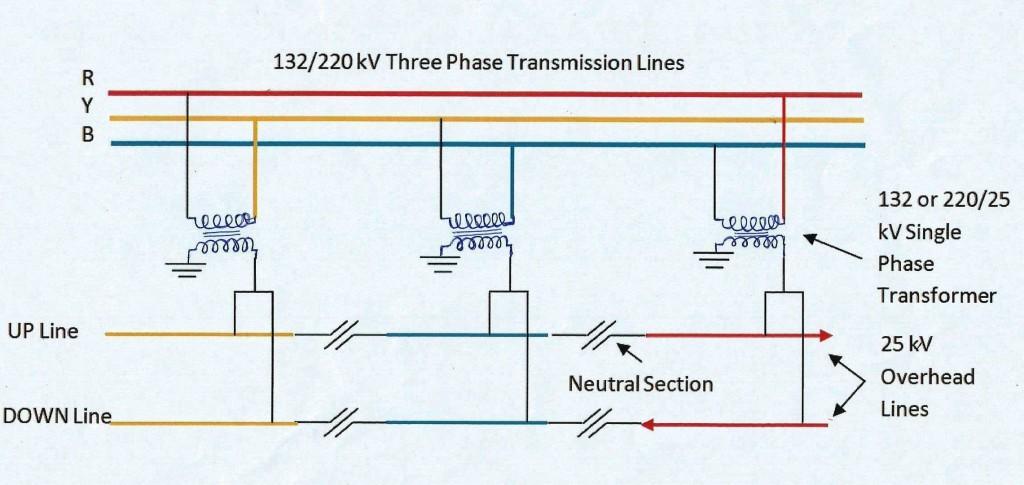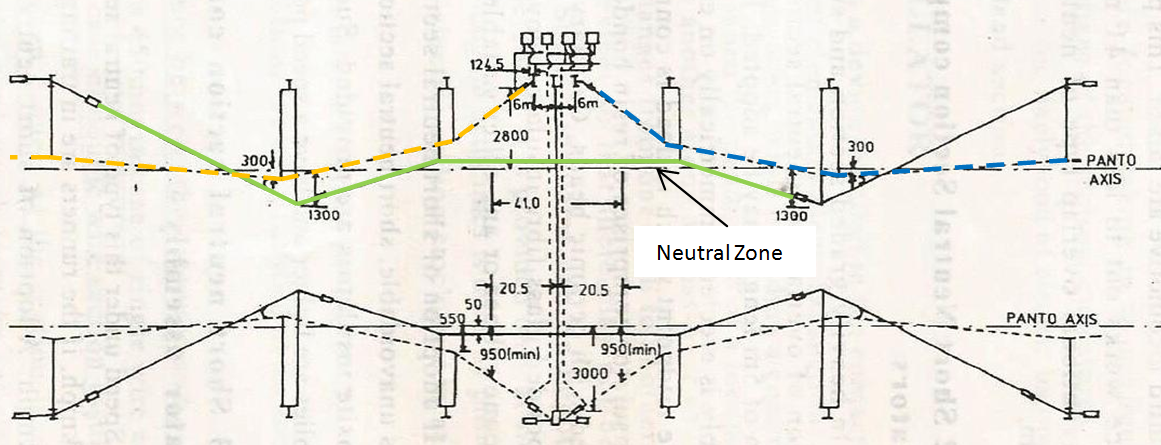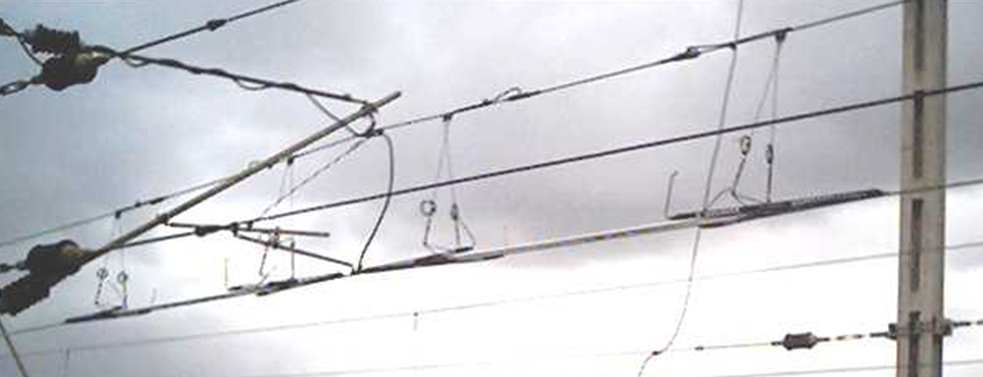Over Head Equipment – Neutral Section
Electrical power is generated in three phases with each phase having a phase shift of 1200. The utility power supply system also expects equal loading on all phases. Traction power system works on single phase 25kV traction system. It now becomes important to use all the three phases equally and convert them into one phase traction supply. This is achieved by feeding single phase supply to the adjacent traction substation which is separated by a neutral section. Each feed covers a distance of about 30-40Km feeding all the trains in that zone. By the theory of probability, equal numbers of trains in feed zone are expected, drawing same load current. In this way un-balancing on utility power supply system is avoided
Neutral Section is defined as short insulated dead overhead equipment separating sectors fed by two adjacent substations which are normally connected to different phases.
The neutral section is a dead zone and therefore, the locomotive has to negotiate the section in momentum. The locomotive is switched off while negotiating the neutral section to avoid flash over at the time of exit and re-entering the live zone. For this, warning board at 500M, 250M and final board for switching OFF and ON are provided. The assistant loco pilot speak out the approaching neutral section loudly to alert the loco pilot. Loco pilot also acknowledges the voice by repeating the approaching neutral section and is in readiness to act so that he should not enter the neutral section with DJ/VCB in ON condition.
Location of Neutral Section
The locomotive negotiates the neutral section in its own momentum. Therefore the location is always so chosen that the physical terrain should not cause inconvenience in the momentum of the train. These are (1) Away from stopping signal and level crossing (2) Away from up gradient preferably on flat or down gradient (3) Away from from sharp curve as it will not provide sufficient straight length to accommodate the neutral section.
Types of Neutral section
There are three types of neutral section namely (1) Conventional Type (2) Short Neutral Section – Section Insulator and PTFE type (3) Dynamic Neutral Section or ASNS type
Conventional Type:
The arrangement consists of five spans of overhead equipment in which the central span has to be strictly of 49.5 m length. This span gives an effective neutral section of 41 m length by proper selection of staggers. Neutral section of 41 m has been designed for three locomotives attached in the front of a train.Dead zone is created by physical separation of dead zone (thick green line) with the live zone of yellow and blue phase . The dead zone provides mechanical continuity for the pantograph movement to support the upward force. The dead zone is charged by the pantograph of the leading locomotive with yellow phase during entering the neutral zone and by blue zone at the time of exiting the neutral section. Length of the neutral section is chosen as 41 m so that accidentally the dead zone is not charged with Y and B phase simultaneously. The advantage of the system is its maintenance free but the main disadvantage is possibility of a locomotive getting struck in the dead zone due to alarm chain pulling or bad driving of loco pilot. This will require a assisted loco be sent to pull the train.
Short Neutral Section
A short neutral section is of 5 m in which the dead zone is electrically insulated by section insulator with mechanical continuity. With section insulators the speed is restricted to 100 Kmph if the runners of the section insulators are in trailing direction or 70 Kmph otherwise. Short neutral section of ceramic beaded resin bonded glass fiber rod insulators are used instead of air gap. These neutral sections are fit for speed up to 200 Kmph.
Dynamic Neutral Section or ASNS type: To be continued




Dear Sir,
Wonderful explanation about the neutral section arrangements. Thank you so much for taking so much pains to have the contents explained in simple manner.
Sir, I have this query. On June 8th, 2015, the section from Mumbra(slowline)-Thane-Mulund -Kanjurmarg-Vidyavihar- Kurla- Sion-Matunga-Currey Rd-Chinchpokli- Sandhurst Rd- CSTM Mumbai of Central Railway was charged/converted from 1500V DC to 25000V AC.
We have AC TSS at Thane, Sion & Chicnhpokli.
We have 25KV SP at Kanjur Marg, Currey Rd
We have 25KV SSP at Mulund, Vidyavihar, Matunga and Sandhurst Rd and we have 25KV FP at CSTM.
However, all 3 AC TSS have been connected in series. There are no AC-AC Neutral Sections at KanjurMarg and Currey Road. In such circumstances, I wish to know how the 3 AC TSS Phases have been made in sync with each other and also, if this type of connection is possible, then why can’t we eliminate AC-AC Neutral sections in suburban sections to achieve a complete continuous AC supply?
Thanks,
Vijay Aravamudhan.
PS: I am a railway enthusiast/ railfan from Thane and deeply interested into electrical department, including operations of EMUs, traction types, knowing EMU types technically, transitioning from DC to AC and vice versa , DC-AC locos etc. This is purely for my knowledge purposes and passion for IR.
In mumbai suburban, only one phase is tapped for supply to three-four sub-stations from the same source and therefore, even though provision of neutural section is kept but paralleled. The voltage difference is very low and accepted as otherwise, frequently opening and closing of DJ/VCB at neutral section is a tough call on part of the motorman.
Can be erected PTFE type neutral section in curve track area
Thanks for your informative website.
Instead of demolishing only British era bridges in the Mumbai suburban section on account of a lack of insulation space for overhead 25KV power supply, why dosent the railways install neutral sections under these bridges ?
Neutral sections are always avoided in sub-urban system to the extent possible as it is difficult to observe regular signal and neutral section alert for the motorman. The same supply phase is used for a very long distance at the in between Traction Substation. The neutral section is provided but the voltage difference is very little to cause any problem.The neutral territory will also get charged for a short time while the panto is sweeping and therefore it will not work to reduce the electrical clearance. So it will not benefit and also not a solution for the infrastructure constraint and shall be rectified. The bridges, in any case are due for rebuilding and renovation. The AC conversion work is implemented by undertaking some innovation techniques like providing insulted pain underneath the bridge etc. which will not last for long.
Rebuilding demolished bridges takes really very long. During the time the old bridge is demolished & the new bridge is built the public living in vicinity of the railway line or even those passengers who used the old bridge tend to take short cuts endangering their lives.
If strongly feel the railways should seriously work out a solution to the problem. In most cases the old bridges are still very sturdy. Instead of demolishing & rebuilding, if a ‘neutral section’ under the bridge is not feasable, the technical staff of the railways should rack their brains for another solution so as to not need demolition of the existing bridge.
This will really be a good solution.
25 kV charging has already been done by finding a temporary solution. Such solutions may not be a lasting solution. However, IR and the local bodies decide about the dismantling only when confirmed that the bridge need dismantling and not fit for safe passage of the public. You shall note that when accident of collapsing old bridges takes place, the blame comes to the Govt. for not acting when the bridge is old.
very easy methode of explanation in students tq so much iam easy to under stand
Dear Sir, Any test method for pulsating load test for PTFE SNS assembly. If so kindly explain.
awesome and relevant information.
Good for OHE knowledge of us
Nive
I need supervisorser my. Phone no 9515518658
Sir,.
Is it possible to erect SI type Short nutralsection on slow speed bypass line/siding line?
The short neutral section will work satisfactorily up to 15 kmph.
If dj is not open at neutral section then which rillay energise to protect ohe
Overlap type neutral Section: one section is charged and another dead and the locomotive in on condition enters the neutral section, Panto flashover relay will act on the logic that if the neutral section is charged, then trip the charged section. If both the section is charged, then the wrong phase coupling (WPC) relay will act.
PTFE type neutral section: The design says nothing should happen but my experience says it will cause flashover and damage to OHE. No test has been done whereas the manufacturer claims that nothing will happen.